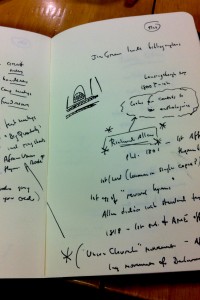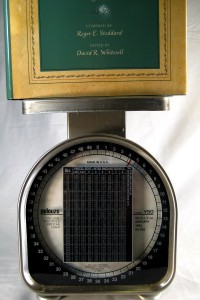I have been remiss in posting anything on the September 29th American Antiquarian Society symposium “Poetry & Print in Early America,” held in celebration of the publication of the long anticipated successor to Wegelin’s Early American Poetry, the fruit of years of work from Roger Stoddard (the compiler) and David Whitesell (the editor), A Bibliographical Description of Books and Pamphlets of American Verse Printed from 1610 through 1820 (University Park, Penna., Published by the Pennsylvania State University Press for the Bibliographical Society of America, 2012, xx, 809, [1] pages, $179.95, available here).
I might claim I held off on my account of the symposium until I had my copy of the bibliography in hand–and the big cinder block of a thing arrived today in my post office box, to great excitement on my part–except that my claim would be but a fig leaf to my sloth. I could easily have written something about the weekend, which I attended as a flag-waving member of the book trade, long ere this, as the symposium was a delight and the talks provided useful and curious knowledge for even this non-scholarly tradesman. (Indeed, the bookseller most esteems useful knowledge–at worst we can be like a bibliographical Nathan Bedford Forrest, concerned only with who got there the firstest with the mostest.)
Anyway, friend and colleague Robert Fraker gave a graceful talk on his unparalleled collection of minor American verse, “Stomach for Them All,” which was an apt summary of the attractions of his long-time pursuit of the Columbian muse, and an account that had (and should he deliver it again, will have) most booksellers and thoughtful librarians nodding in agreement.
I additionally squirreled away nuggets on (say) Richard Allen and the development of print culture with hymns as a legitimizing aspect of the early African Methodist Episcopal church, or the practice of the early Moravian church in America to have its various members sing their hymns together, each in their native tongue–the end result of which must have been a no doubt glorious Babel into which to wander were a notional 18th traveler to stumble into a worship service in Bethlehem, Penna.
(You can find the program for the weekend here, and I will refrain from summaries of the various talks–entertaining all–to instead fall back on that laconic and even moderately stoned refrain more commonly associated I think with fans of jam bands: You had to be there, man. Aside from the intellectual merits of the program, the whole thing seemed like a bibliophilic homecoming weekend–I managed to have at least brief conversations with such friends and colleagues and fellow-travelers as Stuart Bennett, John Crichton, Cheryl Needle, Dan DeSimone, Teri Osborn, Jeremy Dibbel, and Jim Green, as well as a chance to meet various curators at AAS with whom I had done business over the years.)
I haven’t yet had a chance to dig too deeply into my copy of Stoddard & Whitesell, so can’t provide anything like a conscientious review, though I was immediately taken with this remark from Stoddard in his prefatory “Poet and Printer in Colonial and Federal America: Some Bibliographical Perspectives” (republished here from the AAS Proceedings, 1982), where he notes of his early approach to this project,
Finally, I read from cover to cover the most influential texts that any student of American culture can use: Joseph Sabin’s Bibliotheca Americana, Charles Evans’s American bibliography, and the continuation of Evans by Ralph Shaw and Richard Shoemaker.
From my imperfect memory, I would hazard a guess that this would be somewhere between 80 and 90 volumes of bibliographical check-lists. Reading this, a typical bookseller realizes the scope of the intellectual energy behind a truly useful bibliography, and like the widow of Scripture the best he might hope is that his offerings to institutions might someday be a welcome mite in the compilation of future bibliographical endeavors. But even after a cursory examination, I have no doubts that I will enjoy this magnificent doorstop of a book; simply opening the volume at random I stumble across a nice run of Benjamin Allen’s various publications from the year 1814 and am immediately awash with the bookseller’s sentimental desire to possess a copy of Urania, or The true use of poesy (New-York, 1814) and to pencil on its front free endpaper, “Stoddard & Whitesell 1049.”


